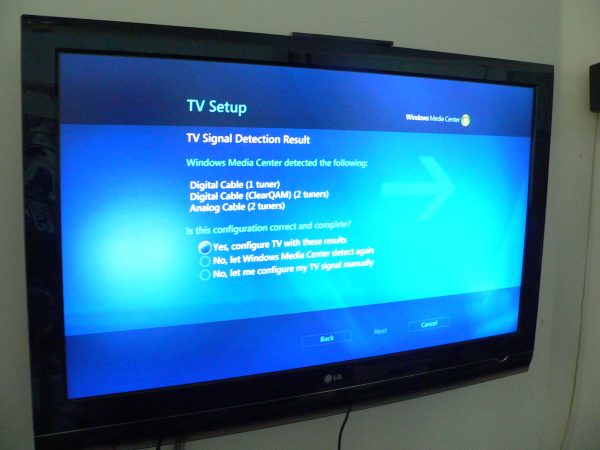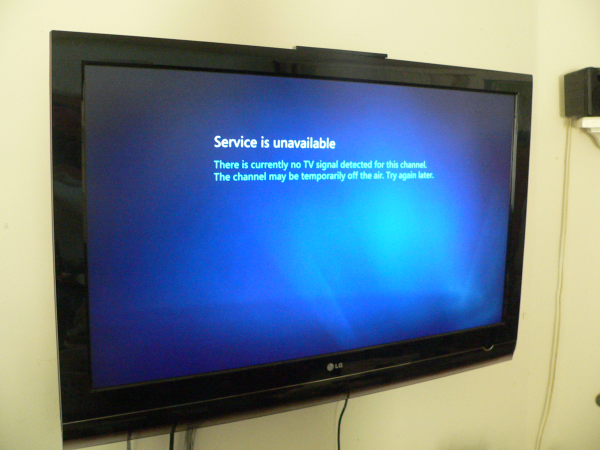Hauppauge HD PVR and Windows Media Center: Is it the working-class TiVo?
The forced marriage of HD PVR and Windows Media Center
It's fair to say that operating HD PVR using the software that ships with it, is far from the "immersive media experience" so poetically described by PR experts during the Consumer Electronics Show each year. More to the point, it's like using Windows. It's for people who enter text in boxes, twiddle scroll wheels, and click on OK. It probably bothers me the least of anyone on Earth, at least when everything works (and in my case, not everything did). But when my wife first saw me testing HD PVR, she was so excited that she asked whether she could install it upstairs on her system and try it out. At first, she blamed the look on my face on greed and avarice, rather than a rational desire to protect her sanity. Then she watched me wrestling with the Registry entries for the drivers for all of about three minutes, and exclaimed, "Jeez, what was I thinking?"
What made Windows Media Center such a good piece of software (as well as systems derived from that software, such as Zune) is that it's the least like Windows of anything Microsoft's ever made. It's painless and simple, and it makes sense right up front. To this day, I find folks discovering it in their Windows installations who are rendered speechless by its usability, who didn't even know it was sitting there, waiting on their PCs for upwards of four years.
"I think that devices have to be easier to use -- they need to be push-button," Hauppauge CEO Ken Plotkin told me. "I think it's unacceptable for consumers to have to configure and install and set up and things like that; it's got to be much, much easier. And in fact, a lot of the products that we're working on are going to be much easier to use."
The perfect recording solution, if there is one, would be for Hauppauge HD PVR to be operable through Windows Media Center. This way, a user could tune her STB through Media Center's program grid, by way of Microsoft's Media Center remote (which comes with HVR-2250, and is one of the best designed remotes you'll ever own) without touching the mouse or twiddling any gadgets or on-screen devices.
Making these two powerful components work together comprised most of Hauppauge's development schedule this past spring. Betanews was honored to be part of at least the first part of the beta cycle for the company's new Media Center driver (mitigating circumstances sadly forced us to bow out of the latter stages).
Actually, marrying HD PVR with Media Center is more of a ménage a trois, the crowd-forming party in this case being the set-top box. Media Center is perfectly capable of managing multiple video sources simultaneously, but HD PVR is a mostly passive device by design. It can't be the tuner, but Media Center has to "believe" it is.
Step 1 in the installation process for Hauppauge's Media Center package is actually de-installation -- getting rid of the old HD PVR driver. Although Hauppauge's instructions clearly state this as Step 1, they don't give a user any pointers or tools with which to do that. You will find the HCWCLEAR.EXE removal utility on Hauppauge's Web site, but only if you're looking for it (or if we give you the link). If you have another Hauppauge device installed, however (as I do), this utility will get rid of that too.
At first, I tried simply uninstalling the old driver from Device Manager, but as learned, that's not enough. Media Center won't recognize HD PVR as a tuner unless the old driver is gone and the Registry entries for WinTV are wiped clean, which apparently only happens after removing all the WinTV entries (there are at least three) from Programs and Features. If you don't remove those WinTV programs completely, then Media Center could think it recognizes your HD PVR device, but when it operates the channel changer, it'll show you dead air. (Total Media Extreme can stay, however, though you might end up never using it.)
Step 2 involves the downloading of two drivers, from this page and this page. Installation instructions may be downloaded from this second page.
Installing the new software comprises the next three steps, the third of which is the least fun and requires that duct tape. For step 3, the new HD PVR Capture Device driver goes on first, and does not go through the lengthy WinTV installation process, so it's much quicker. The only set of questions you'll be asked is about the inputs; if you use the cables Hauppauge supplied you with, you'll choose YPbPr and RCA Front (back). Step 4 has you add what Windows will recognize as the HD PVR Tuner Device, which is the part that connects with Media Center. That's painless.
Step 5 involves installing the IR Blaster cable, which is the red LED hanging by a hair, that you tape to the STB. When you don't know what point on the STB contains the infrared receptor, and the IR Blaster setup software doesn't have a model name attached to the code for your device (which can happen even when you own one of the most common models in America), the process can resemble submarine warfare, sweeping over patches of real estate top-to-bottom and pinging your best guess for the code number along the way. (My Motorola DCH-3200 is Cable Set-Top Box code 0125, by the way).

Step 6 involves making Media Center scan for available channels. If you've done everything correctly up to now, TV Setup should recognize your digital cable source and identify it on-screen, like in the photo above. You won't know whether it's a recordable source, however, until after the full setup process is complete. If you've done everything carefully up to this point, and IR Blaster did not have your STB's product code off-hand, then you've probably expended four hours of work time.
What you have, once all is said and done, is a tuning and recording process that may as well be set up between devices stationed on different planets. It can work, but sometimes not on the first try, and it's not really anyone's fault -- not Hauppauge's, not Microsoft's, not Obama's.
Okay, it might be Comcast's.
Here's the deal: It takes a few seconds for Hauppauge's driver to decode the signal coming in from the STB. Using Total Media Extreme's preview window, you can actually calculate this delay using the STB's native remote control: Press any key on the remote, and measure the interval in-between the keypress and the on-screen response. At most, that interval can be about three seconds. When you're simply watching TV, that's not a qualitative difference; but when you're trying to get three components to behave nicely with one another, it is.
In a recent upgrade to Comcast's system software, several of its HD channels received alternate mappings -- aliases, in a sense -- to four-digit channel numbers, all of which are bunched together. This way, when you surf the four-digit realm, you won't run into any pesky SD channels along the way. Because of this remapping, it can take several seconds for the tuner in the STB to pick up a new channel once it's dialed up -- especially the four-digit channels, but even the three-digit ones as well.
Say you're watching a three-digit channel on your STB, and either you or Media Center dials up a four-digit channel. The time it takes for IR Blaster to key in all four digits may exceed Media Center's internal timeout, so it can either dial up the wrong channel (the first three digits) or no channel at all. In the first case, Media Center won't "know" it's on the wrong channel since HD PVR is a passive device. The text could clearly read, "Indianapolis vs. Washington," but the screen might clearly show Cary Grant vs. Joan Fontaine.
Add that to the three-second natural delay for decoding the signal, and you have a situation where it may take up to 20 seconds (!) for a channel change event to conclude with a clear signal -- maybe the right channel, maybe not.
Through IR Blaster's setup program, you can reduce the number of milliseconds in-between digit presses, to limit the chance of this channel mismatch. However, if you turn down the delay too much, IR Blaster could input something that isn't a digit at all. In any event -- whether it's IR Blaster punching in a long string of digits too slowly, or speeding it up and triggering a signal that the STB can't decipher, or simply taking too long to pull a signal from out of the cable company's substitute for thin air -- the STB ends up tuning in a blank void. HD PVR, seeing no signal coming in from the STB, sends no signal at all to the computer -- not blackness, but rather nothing at all. That makes Windows Media Center conclude that the service as a whole no longer exists.
Finally, in a scene reminiscent of when Windows 95 used to uninstall your printer driver as a service to you whenever you unplugged it from your parallel port with it turned on, Media Center can suddenly come to the conclusion that you have no service attached to your HD PVR whatsoever (see below) -- that Comcast has fallen off the planet.

This gets worse: If you try to change a channel or dial up an HD PVR channel at this point, Media Center can actually lock up, requiring a system reboot. Suppose Media Center weren't taking instructions from you; that instead, it was running a schedule of unattended recordings. You won't be there to reboot the PC, so you could end up recording nothing.
So far, I have been able to successfully record a program overnight on a four-digit channel different from the one the STB is tuned to at the moment. I do have to leave the STB turned on (just as you used to have to leave the VCR turned on), because even though IR Blaster has the theoretical capability of turning on and off your STB, I cannot seem to even manually train my Blaster to do this. It will send digits, but not On/Off.
There's no question that operating the HD PVR is an "immersive" experience, though I'm still searching for a realistic metaphor for what it is I'm being immersed in. I have indeed made good use of the device during my tests, including for transcribing an important family video from a suddenly incompatible camcorder. You might consider buying HD PVR just for that functionality alone.
Is it a make-your-own-TiVo? No, I'm afraid not; if you've already had your heart and mind set on TiVo, there's nothing here that should change them. But that might not be a bad thing, for reasons I explain after the jump.
Next: HD PVR's target market: Me
